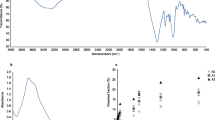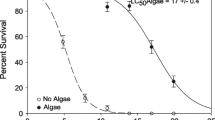Abstract
We investigated the interspecific variation of silver nanoparticle (SNP) sensitivity in common cladocerans (Daphnia magna, D. galeata, and Bosmina longirostris) and the exact cause of both acute and chronic toxicity focusing on the form of silver (NPs and ions). Materials tested were non-surface-coated silver nanocolloids (SNCs) and AgNO3. The results of the acute toxicity tests support the theory that the effects of SNPs on aquatic organisms is mainly due to Ag+ released from SNPs. Among the three cladocerans, D. galeata was more sensitive to silver (as Ag+) than both D. magna and B. longirostris. Moreover, the chronic toxicity of SNCs was also derived from dissolved silver (especially Ag+). SNCs (as total silver concentration) showed far lower chronic compared with acute toxicity to daphnids because the amount of dissolved silver decreased in the presence of prey algae. The chronic end-point values (EC10 values for net reproductive rate and the probability of survival to maturation) did not differ largely from acute ones (48-h EC50 obtained from acute toxicity tests and 48-h LC50 estimated by the biotic ligand model) when the values were calculated based on Ag+ concentration. The α value (concentration at which intrinsic population growth rate is decreased to zero) estimated by a power function model was a reliable parameter for assessing the chronic toxicity of silver.



Similar content being viewed by others
References
Allen HJ, Impellitteri CA, Macke DA, Heckman JL, Poynton HC, Lazorchak JM et al (2010) Effects from filtration, capping agents, and presence/absence of food on the toxicity of silver nanoparticles to Daphnia magna. Environ Toxicol Chem 29:2742–2750
Alonso M (1991) Review of Iberian Cladocera with remarks on ecology and biogeography. Hydrobiologia 225:37–43
Asharani PV, Wu YL, Gong Z, Valiyaveettil S (2008) Toxicity of silver nanoparticles in zebrafish models. Nanotechnology 19:255102
Baumann J, Sakka Y, Bertrand C, Köser J, Filser J (2013) Adaptation of the Daphnia sp. acute toxicity test: miniaturization and prolongation for the testing of nanomaterials. Environ Sci Pollut Res 21:2201–2213
Bianchini A, Wood C (2003) Mechanism of acute silver toxicity in Daphnia magna. Environ Toxicol Chem 22:1361–1367
Bianchini A, Grosell M, Gregory SM, Wood CH (2002) Acute silver toxicity in aquatic animals is a function of sodium uptake rate. Environ Sci Technol 36:1763–1776
Blinova I, Niskanen J, Kajankari P, Kanarbik L, Käkinen A, Tenhu H, Penttinen OP, Kahru A (2013) Toxicity of two types of silver nanoparticles to aquatic crustaceans Daphnia magna and Thamnocephalus platyurus. Environ Sci Pollut Res 20:3456–3463
Bossuyt BTA, Janssen CR (2005) Copper toxicity to different field-collected cladoceran species: intra- and inter-species sensitivity. Environ Pollut 136:145–154
Burchardt AD, Carvalho RN, Valente A, Nativo P, Gilliland D, Garcìa CP et al (2012) Effects of silver nanoparticles in diatom Thalassiosira pseudonana and cyanobacterium Synechococcus sp. Environ Sci Technol 46:11336–11344
Case TJ (2000) An illustrated guide to theoretical ecology. Oxford University Press, New York
Fabrega J, Luoma SN, Tyler CR, Galloway TS, Lead JR (2011) Silver nanoparticles: behaviour and effects in the aquatic environment. Environ Int 37:517–531
Glover CN, Wood CM (2004) Physiological interactions of silver and humic substances in Daphnia magna: effects on reproduction and silver accumulation following an acute silver challenge. Comp Biochem Physiol C 139:273–280
Gottschalk F, Sonderer T, Scholz RW, Nowack B (2009) Modeled environmental concentrations of engineered nanomaterials (TiO2, ZnO, Ag, CNT, fullerenes) for different regions. Environ Sci Technol 43:9216–9222
Grosell M, Nielsen C, Bianchini A (2002) Sodium turnover rate determines sensitivity to acute copper and silver exposure in freshwater animals. Comp Biochem Physiol C 133:287–303
Hogstrand C, Wood CM (1998) Towards a better understanding of the bioavailability, physiology and toxicity of silver to fish: implications for water quality criteria. Environ Toxicol Chem 17:572–578
Kashiwada S, Ariza ME, Kawaguchi T, Nakagame Y, Jayasinghe BS, Gärtner K et al (2012) Silver nanocolloids disrupt Medaka embryogenesis through vital gene expressions. Environ Sci Technol 46:6278–6287
Kennedy AJ, Chappell MA, Bednar AJ, Ryan AC, Laird JG, Stanley JK et al (2012) Impact of organic carbon on the stability and toxicity of fresh and stored silver nanoparticles. Environ Sci Technol 46:10772–10780
Kilham SS, Kreeger DA, Lynn SG, Goulden CE, Herrera L (1998) COMBO: a defined freshwater culture medium for algae and zooplankton. Hydrobiologia 377:147–159
Koivisto S, Ketola M, Walls M (1992) Comparison of five cladoceran species in short- and long-term copper exposure. Hydrobiologia 248:125–136
Milne CJ, Kinniburgh DG, Tipping E (2001) Generic NICA-Donnan model parameters for proton binding by humic substances. Environ Sci Technol 35:2049–2059
Milne CJ, Kinniburgh DG, Van Riemsdijk WH, Tipping E (2003) Generic NICA-Donnan model parameters for metal-ion binding by humic substances. Environ Sci Technol 37:958–971
Muyssen BTA, Janssen CR (2001) Multigeneration zinc acclimation and tolerance in Daphnia magna: implications for water-quality guidelines and ecological risk assessment. Environ Toxicol Chem 20:2053–2060
Navarro E, Baun A, Behra R, Hartmann N, Filser J, Miao AJ et al (2008a) Environmental behavior and ecotoxicity of engineered nanoparticles to algae, plants, and fungi. Ecotoxicology 17:372–386
Navarro E, Piccapietra F, Wagner B, Marconi F, Kaegi R, Odzak N et al (2008b) Toxicity of silver nanoparticles to Chlamydomonas reinhardtii. Environ Sci Technol 42:8959–8964
Nebeker AV, McAuliffe CK, Mshar R, Stevens DG (1983) Toxicity of silver to steelhead and rainbow trout, fathead minnows and Daphnia magna. Environ Toxicol Chem 2:95–104
Newton KM, Puppala H, Kitchens CL, Colvin VL, Klaine SJ (2013) Silver nanoparticles toxicity to Daphnia magna is a function of dissolved silver concentration. Environ Toxicol Chem 32:2356–2364
Niyogi S, Wood CM (2004) Biotic ligand model, a flexible tool for developing site-specific water quality guidelines for metals. Environ Sci Technol 38:6177–6192
Organisation for Economic Co-operation and Development (OECD) (2004) OECD guidelines for testing of chemicals, no. 202: Daphnia sp., acute immobilization test. OECD, Paris
Organisation for Economic Co-operation and Development (OECD) (2012) OECD guidelines for testing of chemicals, no. 211: Daphnia magna reproduction test. OECD, Paris
Poynton HC, Lazorchak JM, Impellitteri A, Blalock BJ, Rogers K, Allen HJ, Loguinov A, Heckman JL, Govidnaswamy S (2012) Toxicogenomic responses of nanotoxicity in Daphnia magna exposed to silver nitrate and coated silver nanoparticles. Environ Sci Technol 46:6288–6296
Ribeiro F, Gallego-Urrea JA, Jurkschat K, Crossley A, Hassellöv M, Taylor C et al (2014) Silver nanoparticles and silver nitrate induce high toxicity to Pseudokirchneriella subcapitata, Daphnia magna and Danio rerio. Sci Total Environ 466–467:232–241
Ritz C, Streibig JC (2005) Bioassay analysis using R. J Stat Softw 12:1–22
Sakamoto M, Chang KH, Hanazato T (2005) Differential sensitivity of a predacious cladoceran (Leptodora) and its prey (the cladoceran Bosmina) to the insecticide carbaryl: results of acute toxicity tests. B Environ Contam Tox 75:28–33
Sakamoto M, Tanaka Y (2013) Different tolerance of zooplankton communities to insecticide application depending on the species composition. J Ecol Environ 36:141–150
Stearns SC (1992) The evolution of life histories. Oxford University Press, New York
Stensberg MC, Madangopal R, Yale G, Wei Q, Ochoa-Acuña H, Wei A et al (2014) Silver nanoparticles-specific mitotoxicity in Daphnia magna. Nanotoxicology 8:833–842
Stevenson LM, Dickson H, Klanjscek T, Keller AA, McCauley E, Nisbet RM (2013) Environmental feedbacks and engineered nanoparticles: mitigation of silver nanoparticle toxicity to Chlamydomonas reinhardtii by algal-produced organic compounds. PLoS ONE 8:e74456
Tanaka Y, Nakanishi J (2001) Model selection and parameterization of the concentration-response function for population-level effects. Environ Toxicol Chem 20:1857–1865
Vesela S, Vijverberg J (2007) Effect of body size on toxicity of zinc in neonates of four differently sized Daphnia species. Aquat Ecol 41:67–73
Völker C, Boedicker C, Daubenthaler J, Oetken M, Oehlmann J (2013) Comparative toxicity assessment of nanosilver on three Daphnia species in acute, chronic and multi-generation experiments. PLoS One 8:e75026
Zhao CM, Wang WX (2011) Comparison of acute and chronic toxicity of silver nanoparticles and silver nitrate to Daphnia magna. Environ Toxicol Chem 30:885–892
Zhao CM, Wang WX (2012) Size-dependent uptake of silver nanoparticles in Daphnia magna. Environ Sci Technol 46:11345–11351
Acknowledgments
The authors thank N. Watanabe for kind assistance during the experiments. We are grateful to T. Kusui for helpful comments on this study. This study was supported by Grants-in-Aid for Scientific Research to M. Sakamoto (Grant No. 23510031) and to S. Kashiwada (Grant No. 23310026) from Japan Society for the Promotion of Science.
Author information
Authors and Affiliations
Corresponding author
Rights and permissions
About this article
Cite this article
Sakamoto, M., Ha, JY., Yoneshima, S. et al. Free Silver Ion as the Main Cause of Acute and Chronic Toxicity of Silver Nanoparticles to Cladocerans. Arch Environ Contam Toxicol 68, 500–509 (2015). https://doi.org/10.1007/s00244-014-0091-x
Received:
Accepted:
Published:
Issue Date:
DOI: https://doi.org/10.1007/s00244-014-0091-x




